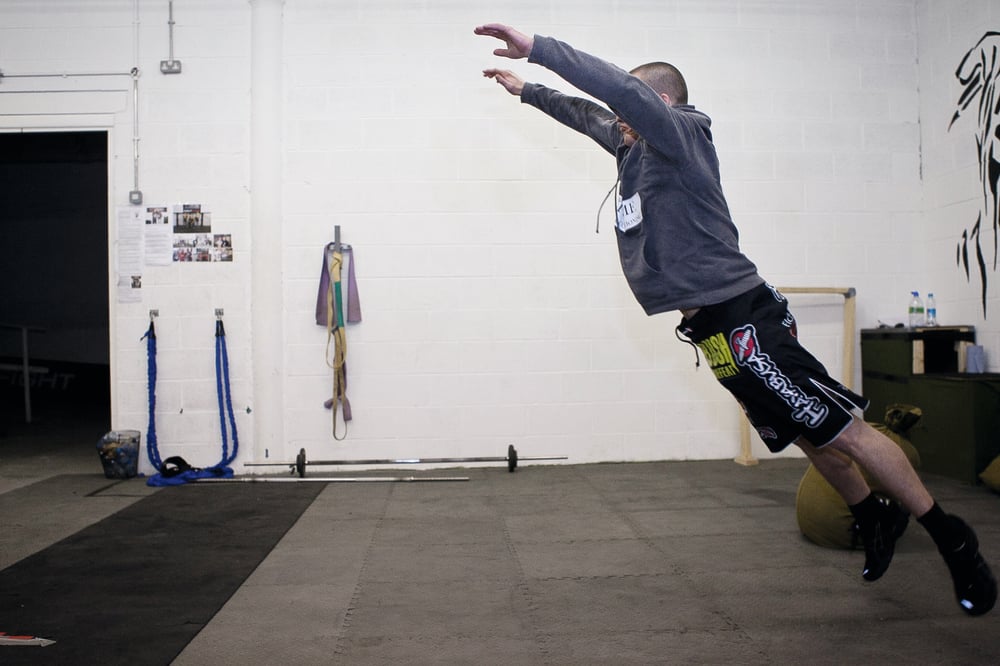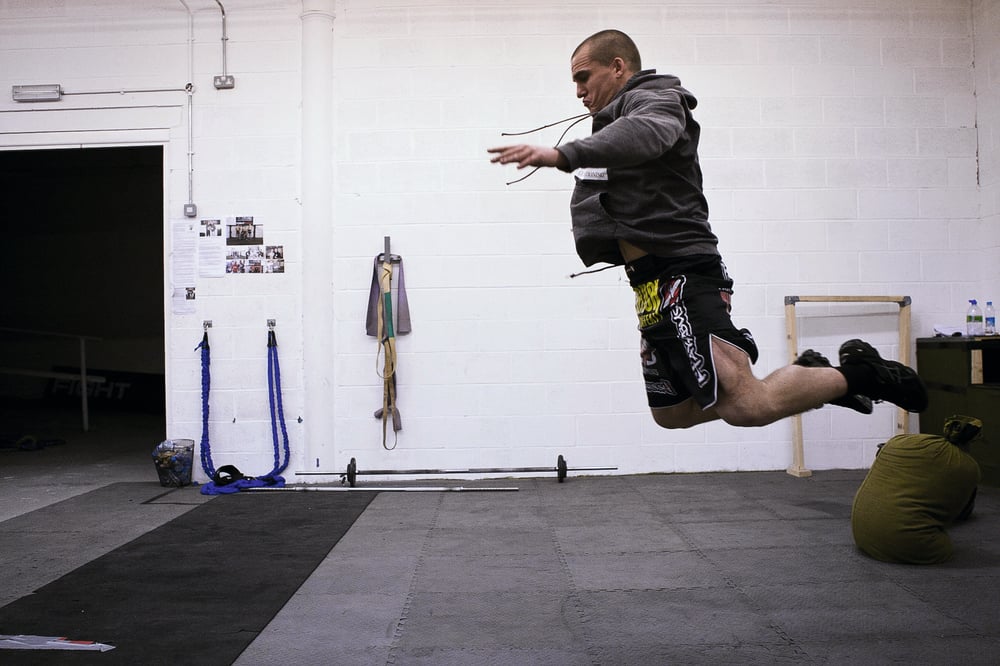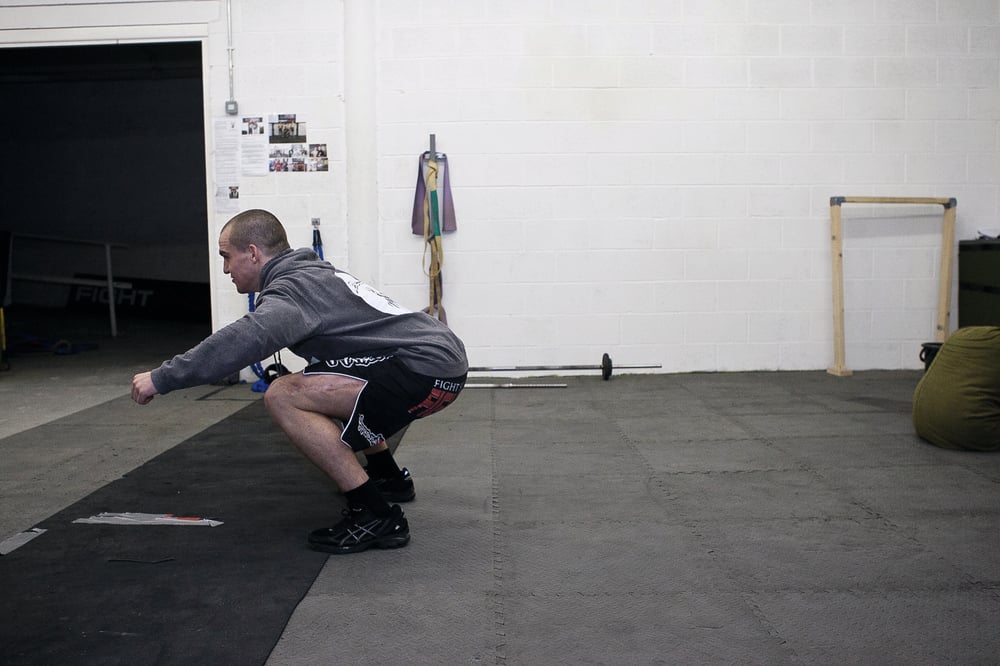
Issue 078
August 2011
Paul McVeigh is a sports scientist and a professional fighter, ranked as the number-one bantamweight in Europe. Jump-training essentials to increase your explosive lower-body power.
Last issue we had a look at developing serious upper-body power with medicine balls, so let’s focus on developing power in the lower body using gravity. Everyone from your favorite fighter to the weekend warrior loves jump training; it looks cool and it’s super fun. Nothing makes you feel more like an athlete than springing over a bunch of high hurdles.
The problem is that many athletes advance too quickly and start rocking out depth jumps on day one. As with all forms of training, progression is key to long-term development. Just because you can make a passable attempt at a more advanced exercise doesn’t mean you should begin with it.
Jump training is designed to make the nervous system more efficient at redirecting force. When an athlete lands from a jump, muscles and connective tissue are stretched in the ankles knees and hips. Due to the elastic nature of the musculature, more force can be generated when the athlete reverses the direction of the movement.
Jump training utilizes this stretch shortening cycle to help the athlete develop the reactive abilities of a bouncy ball. A more efficient nervous system will correspond to crisper footwork, more powerful striking and takedowns from hell.

Terminology
There are three categories of jumps I use and it is important to clarify the difference:
- Jumps: double-foot take-off and landing
- Hops: single-leg take-off and landing
- Bounds: single-leg take-off, alternate-leg landing.
I try to use all three variations within the training week. Alternating between linear (straight ahead) and lateral variations (to the side). We do not use lateral jumps as they have a tendency to become lateral bounds. Jump training is neurologically demanding and for this reason it should take place before strength training. Another thing to remember is this form of training is not a conditioning tool, we are trying to develop reactive ability so more is not necessarily better. The focus should be on force production and the quality of movement.

Progressions
With all these jumps, hops and bounds the aim is to land softly and absorb the impact of landing. Think ninja not baby elephant. Each phase lasts for three weeks, the athlete only progresses if form was perfect on the previous phase.
The first prerequisite to jump training is to ensure the athlete has the ability to absorb the landing impact safely (eccentric strength) before progressing to more advanced exercises. In Phase 1 the jumps and both varieties of hops use a box. By jumping and hopping to a box we reduce the landing impact and eccentric strength requirement. It can be tempting when doing box jumps to find the highest box you can and let rip. But you want to land upon the box in the same position you took off in. If you have to squat lower to hit your landing the box is too high.
We have two phases of bounds, both lateral and linear. In the first phase we stick the landing for two seconds and after three weeks we move into the multiple-response (no pause between) bound for subsequent phases.
After three weeks of box jumps and hops we can progress to phase two. In this phase the gravity component and subsequent eccentric strength demand is increased by the use of hurdles. The athlete jumps and hops over some hurdles and the landing is stuck for two seconds.
In Phase 3 we perform the Phase 2 movements but this time with a double bounce between hurdles. And finally in Phase 4 there is no pause between hurdle jumps. Subsequent progression from this point is made by increasing the hurdle height.
In Phase 1 and 2 we are looking to develop the eccentric strength necessary to use jump training safely. It is only in Phase 3 and 4 that we begin to really use the stretch shortening cycle to full effect. However, the athlete can expect to see increases in lower-body power throughout every phase. Consistency, technique and adhering to the progressions are the keys to reaping the benefits of jump training.

Jumps: Linear only
PHASE 1: Box jump
PHASE 2: Hurdle jump and stick
PHASE 3: Hurdle jump with bounce
PHASE 4: Hurdle jump multiple response
Hops: Lateral, medial and linear
PHASE 1: Box hop
PHASE 2: Hurdle hop and stick
PHASE 3: Hurdle hop with bounce
PHASE 4: Hurdle hop multiple response
Bounds: Linear and lateral
PHASE 1: Bound with stick
PHASE 2:
PHASE 3: Bound multiple response
PHASE.4:










